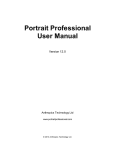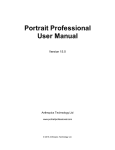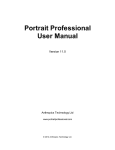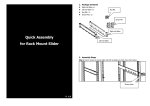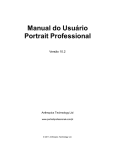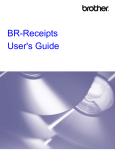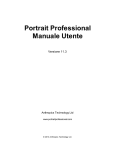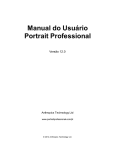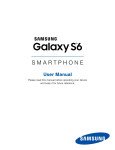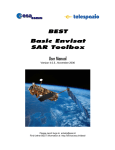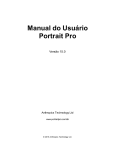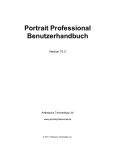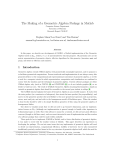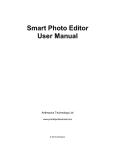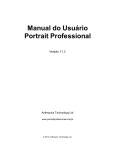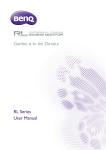Download Mac Manual - Portrait Professional
Transcript
Portrait Professional
User Manual
Version 10.2
Anthropics Technology Ltd
www.portraitprofessional.com
© 2011 Anthropics Technology Ltd.
Contents
3
Table of Contents
Part I Getting Started
6
1 Quick Start
...................................................................................................................................
Guide
6
2 Top Tips
...................................................................................................................................
For Best Results
9
3 Portrait
...................................................................................................................................
Professional Editions
10
Part II Step By Step Guide
12
1 Open...................................................................................................................................
An Image
12
2 Select...................................................................................................................................
Gender
13
3 Locate
...................................................................................................................................
The Main Features
14
4 Adjust...................................................................................................................................
The Outline
15
5 Enhance
...................................................................................................................................
The Image
19
6 Group...................................................................................................................................
Shots
20
7 Full Body
...................................................................................................................................
Enhancement
20
8 Plug-in
...................................................................................................................................
Mode
20
Part III Reference
24
1 Menu...................................................................................................................................
Commands Reference
24
File Menu
.......................................................................................................................................................... 24
Edit Menu
.......................................................................................................................................................... 26
Full Body Skin.......................................................................................................................................................... 26
View Menu .......................................................................................................................................................... 26
Help Menu .......................................................................................................................................................... 27
2 Controls
...................................................................................................................................
Panel Reference
28
Back and Next..........................................................................................................................................................
Buttons
29
Zoom Control.......................................................................................................................................................... 31
Saved Sliders.......................................................................................................................................................... 33
Slider Controls
.......................................................................................................................................................... 35
Face Sculpt Controls
.......................................................................................................................................................... 36
Skin Controls.......................................................................................................................................................... 38
Eye Controls .......................................................................................................................................................... 42
Mouth & Nose..........................................................................................................................................................
Controls
45
Hair Controls .......................................................................................................................................................... 46
Skin Lighting ..........................................................................................................................................................
Controls
47
Picture Controls
.......................................................................................................................................................... 48
Skin Area Tools
.......................................................................................................................................................... 49
Hair Area Tools
.......................................................................................................................................................... 50
3 Dialogs
...................................................................................................................................
Reference
51
Save Im age Options
.......................................................................................................................................................... 51
Settings
.......................................................................................................................................................... 52
General Settings
......................................................................................................................................................... 53
Color Settings
......................................................................................................................................................... 54
Language Settings
......................................................................................................................................................... 56
© 2011 Anthropics Technology Ltd.
3
4
Portrait Professional 10
Plugin
......................................................................................................................................................... 57
Save Sliders .......................................................................................................................................................... 59
Manage Saved..........................................................................................................................................................
Sliders
61
Skin Area
.......................................................................................................................................................... 62
Batch
.......................................................................................................................................................... 62
4 Tools...................................................................................................................................
Reference
65
Pan Tool
.......................................................................................................................................................... 65
Brush Tools .......................................................................................................................................................... 65
Area Brush Tools
.......................................................................................................................................................... 66
Crop Tool
.......................................................................................................................................................... 67
5 Third ...................................................................................................................................
Party Credits
68
6 Supported
...................................................................................................................................
File Types
71
7 Keyboard
...................................................................................................................................
Shortcuts
72
Index
75
© 2011 Anthropics Technology Ltd.
Part
I
6
1
Portrait Professional 10
Getting Started
Introduction
Portrait Professional is the easiest and fastest way to re-touch portraits in just five easy steps, allowing you to
achieve professional results in minutes.
Portrait Professional works in a completely different way to ordinary airbrushing and photo editing software
normally used by the pros. Portrait Professional has been trained with hundreds of examples of human beauty,
and as a result you can add as much or as little photo enhancement as required - by simply moving sliders.
In fact due to the innate knowledge of human beauty built into Portrait Professional, the highest quality photo
touch-up can be achieved by anyone in just a few minutes.
Portrait Professional is available in three editions
by this manual.
10
, Standard, Studio and Studio64. All editions are covered
Portrait Professional is available for Windows and Mac computers. This manual is for the Mac version.
Getting Started
Take a look at the Quick Start Guide
The Step By Step Guide
12
6
to see a quick overview of how to use Portrait Professional.
provides more detailed information about each step.
If you need further help, please visit www.portraitprofessional.com/support where you see the latest FAQ, and
access our support ticket system. The support ticket system lets you send a question to our support staff.
1.1
Quick Start Guide
Portrait Professional will guide you through each step but have a look at the quick start guide below to
familiarize yourself with the stages.
Step 1 - Select the image to enhance
When you open Portrait Professional, you will get the welcome screen.
To edit your own picture click on the Open button, or select Open... from the File menu. This brings up the file
open dialog where you can select the image you want to load.
If you don't have an image to hand, you can click on one of the example pictures instead.
Portrait Professional will load your image and show it in the main working area.
Learn more about step 1.
12
Step 2 - Select the gender of the face you want to enhance
Click on the female or male button to let Portrait Professional know whether the face is a female or male face.
If the image is not the right way up, click on the orientation button that matches the orientation of your image to
rotate your image. The orientation buttons are at the bottom of the controls panel.
Learn more about step 2
13
.
© 2011 Anthropics Technology Ltd.
Getting Started
7
Step 3 - Click on 5 key points on the face
Click on each of the following points on the face in your image:
As you click on each point, Portrait Professional will automatically move on to the next point.
You will be shown an example image to help you know where to place each point.
You can adjust the position of any points you have already marked by clicking on one of those points and
dragging it.
Learn more about step 3.
14
Step 4 - Adjust the outlines of features and face
Portrait Professional will take you to each of the features in turn so that you can check, and if need be, adjust
the positioning of the selected outline of each feature.
The important points are those around the eyes and mouth. The remaining points do not need to be marked
accurately, so you should only need to spend a few seconds on this step. Generally the smaller the
adjustments you make here, the better the results.
© 2011 Anthropics Technology Ltd.
8
Portrait Professional 10
To adjust any of the marked positions, move the mouse pointer over any of the small blue or white boxes on
the blue lines and then hold down the left mouse button whilst you drag the box to its new position. To get the
best results always drag the shortest distance possible.
After you have adjusted each position (or if no adjustment is necessary), press the space bar or click on the
Next button.
Learn more about step 4.
15
Step 5 - View the enhanced image and fine tune the results
Portrait Professional will now start its automatic photo enhancement processing. Depending on the power of
your PC this should only take a few seconds. When finished you will see the original portrait on the left of the
screen and the enhanced version on the right (you can change this using the View Before And After and View
After Only tabs at the top right of the picture).
Hold down the ENTER key to flip between the before and after picture to see the improvements.
Many people are happy with this initial enhancement, in which case you have just finished retouching your first
picture using Portrait Professional. However, you can very quickly and easily fine tune any of the enhancements
using the controls on the right hand side of the screen, to get any result you want from heavily airbrushed
glamour effects to natural beauty.
At any time, you can now save your enhanced portrait by selecting "Save" from the File menu
of the screen.
24
at the top left
You can also save the whole project by choosing "Save Session" – this allows you to come back and edit the
portrait at a later time without having to go through Steps 1 – 4 again.
Occasionally, inaccurate positioning of the face points can cause problems such as slight distortion of the face
© 2011 Anthropics Technology Ltd.
Getting Started
9
or lips. To correct this, you can go back and adjust the points at any time by clicking on the Back button in the
top left of the controls panel.
If there is more than one face in the picture, select "Enhance Another Face In This Photo" from the File menu.
Note that this takes you back to the very start of the process and you will not be able to save the picture again
until you get back to the final stage.
Learn more about step 5.
1.2
19
Top Tips For Best Results
If you just read one page in this manual, make it this one to get the best results out of Portrait Professional.
Don't spend too long adjusting the outline
The Adjust The Outline
15
stage shouldn't take you very long.
You don't need to painstakingly position every point. In fact, you will get better results if you don't.
The only points that need to be accurately positioned are those around the eyes and mouth. For other points, if
it is automatically placed in roughly the right place, resist the urge to make tiny changes to its position.
Move points as little as possible
When adjusting the outline
15
, move points as little as possible to get them to the right place.
For example, when moving the points around the mouth, or around the face, just move them in or out to get
them on the perimeter. Try to avoid moving the points around the perimeter.
The exception is corner points. The points at the corners of the eyes, or the corners of the mouth must go in the
right place.
Don't push the sliders up too far
Often, you can greatly improve a picture with fairly subtle changes.
Push the sliders up just far enough to get the results you want.
If you go too far, the result can look unnatural or faked.
Don't use the sliders to fix small blemishes
You can avoid the need to push the sliders up too far by using the Touch-Up 38 tool to clean up spots and
blemishes. This is better than pushing the sliders further up because that affects the whole face.
Make sure the skin area is right
Portrait Professional automatically works out which areas in your picture are skin. However, the automatic area
selected can sometimes be adjusted to improve the results.
Use the skin Extend and Cut Back
© 2011 Anthropics Technology Ltd.
49
tools to paint over any skin areas that are wrong.
10
1.3
Portrait Professional 10
Portrait Professional Editions
Portrait Professional comes in three editions, Standard, Studio and Studio 64. The Standard edition is
intended for more casual users or amateur photographers. The Studio edition is intended for enthusiast or
professional users. The Studio and Studio 64 editions have all of the same features. The difference is that
while the Studio edition is a 32-bit application, Studio 64 is a 64-bit application. This means it has access to
all of the memory in your computer and so can handle larger images.
This manual covers all editions, with features that are only available in the Studio/Studio 64 edition indicated
like this:
Studio Edition Only
The main differences between the Standard and Studio editions are listed below.
Photoshop plug-in support
Read RAW image files
files
71
57
, and Adobe DNG
16 bits per color sample support (48 bits per
pixel)
The Studio edition comes with a Photoshop plug-in
component. This allows you to open an image in Portrait
Professional Studio directly from within Photoshop. When
you have finished enhancing the image in Portrait
Professional, the result is automatically loaded back into
Photoshop.
Only the Studio edition can read RAW image files and Adobe
DNG files.
The Studio edition can work with images containing 16 bits
per color sample (48 bits per RGB pixel). The Standard
edition is limited to 8 bits per color sample (24 bits per RGB
pixel). RAW images typically contain more than 8 bits per
color sample, so the Studio edition allows this extra
information to be preserved.
The Studio edition can read and write TIFF files containing
16 bits per color sample. The Standard edition cannot.
The JPEG file format does not support 16 bits per color
sample, so if an image containing 16 bits per color sample
is saved to a JPEG file, it will automatically be converted to 8
bits per color sample.
Color profile support
54
Improved work-flow when enhancing multiple
images 62
Images can contain extra information about the "color
space" that is used by the RGB color values. If this
information is ignored, the colors that appear on the screen,
and the colors in any file saved out may not be correct. Only
the Studio edition reads, writes and applies this color space
information.
The Studio edition allows you to select multiple files using
the file browser to set up a list of files to work through. This
speeds up your work-flow, since you can use a single
command after enhancing each image to save the result
and load the next one.
© 2011 Anthropics Technology Ltd.
Part
II
12
2
Portrait Professional 10
Step By Step Guide
To enhance an image with Portrait Professional, you just need to follow a simple five step process.
The following sections describe each step in detail.
Step 1 - Open An Image
Step 2 - Select Gender
12
13
Step 3 - Locate The Main Features
Step 4 - Adjust The Outline
15
Step 5 - Enhance The Image
2.1
14
19
Open An Image
The Portrait Professional Welcome screen
When you run Portrait Professional, it begins with the welcome screen:
Open an image
To open an image to enhance, either:
Press the Open Image button, or
Select the Open command in the File menu
24
.
This will bring up the File Open panel:
© 2011 Anthropics Technology Ltd.
Step By Step Guide
13
Browse to the file you want to enhance, and press the Open button.
Alternatively, click on one of the example images if you want to try the application and don't have any suitable
images to hand.
2.2
Select Gender
Select the gender
Portrait Professional needs to know the gender of the face being enhanced. This is because some of the
enhancements depend on the gender to give the best result possible.
Press the Female button if the face is female (keyboard shortcut: f).
Press the Male button if the face is male (keyboard shortcut: m).
If the face is a child (under about 10 years old), check the Child checkbox. This will improve the results when
enhancing children.
Portrait Professional will automatically advance to the next step once you have selected the gender.
© 2011 Anthropics Technology Ltd.
14
Portrait Professional 10
Enhancing skin only
If there is no face in the picture, press the Enhance Skin Only button. When you press this button, you will then
be asked to select the skin area by painting over it using brush tools.
This option is only intended to be used if you want to use the skin enhancing when there is no face in the
picture. If there is a face, you will get much better results if you select the gender and follow the usual steps to
position the lines over the face. This will also usually be quicker since the skin area will be automatically
selected.
If the Enhance Skin Only button is not shown, you need to enable it using the Show "Enhance Skin Only"
Button checkbox in the General Settings 53 dialog.
Adjust the image orientation
If your image is not the right way up, click on one of the buttons at the bottom of the controls panel. This will
rotate your image in the direction shown by the arrows.
Note that you need to change the orientation before selecting the gender, since Portrait Professional
automatically advances to the next step when you select the gender.
2.3
Locate The Main Features
After you have opened an image and selected the gender, the next step is to locate the positions of 5 key
features on the face.
The 5 key features are:
© 2011 Anthropics Technology Ltd.
Step By Step Guide
15
Locating the feature points
In the controls panel you can see an example of which point you need to click on next, as an image and as a
text description.
Click on the corresponding position in your image.
If you hold down the mouse button when clicking in your image, you can see a cross appear. You can then
drag the mouse to reposition the cross.
The cross will have a small text label next to it to remind you which point you are locating. These labels can be
turned off if you don't like them using the General Settings 53 panel.
As soon as you release the mouse after clicking, Portrait Professional automatically asks you to select the next
feature position. However, if you want to adjust the positions of any of the points you have already located, you
can click on them and drag them.
Profile views
If the face is viewed side on, press the Profile View button at the bottom of the control panel.
If you are not sure whether the face is being viewed in profile or not, the main test is whether you can see both
eyes. If you can't see one of the eyes due to the head being turned, press the Profile View button.
When you press the Profile View button, you will only need to locate one eye point, the nose tip, and one mouth
point.
2.4
Adjust The Outline
Viewing and moving the outline
After the main feature points have been located 14 , you can adjust the outlines around those features so that
Portrait Professional knows more accurately where each feature is.
© 2011 Anthropics Technology Ltd.
16
Portrait Professional 10
Skipping this step
If you do not want to make any changes to the face shape, or any enhancements to the eyes or mouth, you can
skip this step by pressing the Skip button, which is to the left of the Next button.
If you press the Skip button, you will go straight to the final stage where you can view the enhanced image.
However, some of the sliders (those that make changes that need the outline to be accurately placed) will not
be available.
If you make any changes to the outline positions, the skip button will no longer be shown. You will then need to
press the Next button instead, to go through the rest of the features as described below.
Note: if this button does not appear, make sure the option Show "Skip To Final Step" Button is checked on
the General Settings 53 dialog. Also, once you start making any changes to the outline, the skip button
becomes hidden.
Adjusting the outline
The outline is shown as blue lines overlaid over your image in the main working view. The lines can be moved
by dragging the small squares.
There are two types of squares, both of which can be moved by clicking on them and dragging.
The box-like light green squares - these are points that have been automatically placed, based on the
positions of the points that you have placed.
The small blue squares - these are points that you have placed. To begin with, just the 5 points that you
located in the previous step are blue.
Whenever you drag a light green square, it will turn into a blue square to let you know that it is a point that you
have positioned.
Since the light green squares are automatically positioned based on the squares that you have placed,
whenever you move a square the positions of some or all of the green squares may change.
For best results, try to move as few points as possible to line up the outline. Any points you
do move, try to move as little as possible. If you spend a long time carefully adjusting every
© 2011 Anthropics Technology Ltd.
Step By Step Guide
17
point, not only are you wasting time, but you are likely to end up with a worse result.
After you have adjusted each position (or if no adjustment is necessary), press the space bar or click on the
Next button.
Adjusting the outline for each feature
Portrait Professional will take you to each of the features in turn so that you can check, and if necessary, adjust
the positioning of the selected outline of each feature.
You should only need to spend a few seconds on this step as Portrait Professional does not need to have the
positions marked completely accurately. Generally the smaller the adjustments you make here, the better the
results.
Once you have been through all the features, press the Next button one more time to start Portrait Professional
processing your image. You will then be taken to the Enhance Image 19 step, where the fun begins!
The features
The features are shown in the following order.
Left eye and eyebrow
The left corner of the left eye is in the position you selected in the previous step, locating the main features
14
.
You may want to adjust it now that the image is zoomed in more closely on the eye, along with the other points
around the eye.
Two blue circles are shown inside the eye. The smaller circle should fit around the pupil (the black part in the
© 2011 Anthropics Technology Ltd.
18
Portrait Professional 10
middle of the eye). The larger circle should fit around the iris (the colored part of the eye). These circles are
positioned automatically, so you will not usually need to adjust them. If they are in the wrong place, wait until
the eye outline has been set before adjusting them since the circle positions may be fixed once the eye outline
is correct.
If you do need to move the circles, click on the point in the center of the circles. This lets you reposition the
circles.
If you click on the eye center point, two more points appear, one on each circle. These points let you adjust the
sizes of the circles so that they fit around the pupil and iris respectively. The positions of these points around
the circle don't matter, they are only used to set the sizes of the circles.
Depending on the shape of the eyebrow, it can be difficult to get the outline to fit around the eyebrow. In these
cases, it is best to not worry about it and just get the position roughly correct. Even if you are able to get the
outline to fit around the eyebrow reasonably well, if you had to move the points a lot to get it to fit, you may get a
better result by moving the points less even if the eyebrow outline no longer goes around the eyebrow
accurately.
Right eye and eyebrow
The same comments about the left eye and eyebrow apply to the right eye and eyebrow.
Nose and Mouth
When you get to this stage the Mouth Open Or Closed panel will appear, provided it has not been turned off in
the General Settings 53 . This panel has two buttons:
Mouth Open
Press this button if the mouth of the face you are enhancing is open. You will then
see four lines between the corners of the mouth. The top two should be positioned
around the upper lip, and the bottom two around the lower lip. If the line along the
bottom of the top lip is placed close to the line along the top of the bottom lip, you
will see the line along the top of the bottom lip disappear leaving just the control
point in the middle. The mouth will then be treated as closed anyway.
Mouth Closed
Press this button if the mouth is closed. You will then see only three lines between
the corners of the mouth. The center line should be placed along the line where
the lips meet.
If you are used to pressing the spacebar to quickly move on to the next stage, note you can
also use this to dismiss the dialog asking if the mouth is open or closed. If this happens, the
mouth will be selected as being open. If the mouth is in fact shut, you can either press the
Back button followed by the Next button, and the panel will appear again, or you can simply
move the middle two lines together.
Face outline
The face outline does not need to be set accurately. The same rule applies here, that you will get the best
results if you only move those points that need it, and move those as little as possible.
Try to avoid moving the face outline points around the face, just move them towards or away from the face.
© 2011 Anthropics Technology Ltd.
Step By Step Guide
2.5
19
Enhance The Image
After you have adjusted the outline around the face in your image, you are ready to start enhancing the image.
Viewing the result
You can choose whether you want to see the before and after image side by side, or whether you just want the
enhanced image as large as possible. Use the tabs above the images to select which option you prefer.
Whichever option you use, you can always flip the enhanced ("after") image back to the original to see the
changes by pressing and holding the Enter key.
Changing the result
Portrait Professional will automatically enhance your image when you reach this stage. See Saved Sliders
for how to configure this default enhancement.
You can change how the image is enhanced by moving the sliders in the Controls panel
28
33
.
The sliders are grouped into sections that control various aspects of the face. When you first enter this stage,
the Face Sculpt Controls 36 and Skin Controls 38 sections are open, and the others are closed. Sections can
be opened or closed by clicking on their title button. This has a small triangle pointing down if the section is
open, or right if the section is closed.
Try moving the Master Fade slider in each section to get an idea of the overall effect controlled by that section.
The lower sliders in each section give you finer control over the effect.
Portrait Professional also comes with a set of Saved Sliders 33 settings, which set some or all of the sliders
to pre-defined values to get a particular effect. You can go through these to see some of the types of
enhancement possible for your photo.
Fixing problems
Most problems with the enhanced images are caused either by one or more sliders being pushed up too far,
or by the skin or hair areas being wrong.
Use the Brush tools
65
to fix the skin and hair areas.
Saving the result
To save the result, select the Save command from the File Menu
24
or from the Next button at the top left.
This lets you save the enhanced image as a JPEG image file. The Save Jpg/Tiff option allows saving JPEG
files with extra options, and also TIFF file saving.
If you would like to save all the settings so that you can reload your image and continuing adjusting the sliders,
select the Save Session command from the File Menu. This saves the original image, all the point positions,
the skin and hair areas and all the sliders values into a proprietary ".pp" file.
© 2011 Anthropics Technology Ltd.
20
2.6
Portrait Professional 10
Group Shots
Working with group shots
If there is more than one face in your image, you simply need to go through the enhancement process with
each face one by one.
Start by locating the feature points on one of the faces, and then go through the remaining steps until you are
happy with how the face has been enhanced.
You can then repeat the process for any other faces in the image.
To return to the start of the process to enhance the next face, either
Select the menu command File > Enhance Another Face In This Photo (keyboard shortcut CTRL+E), or
Press the Next Button
29
and select Enhance Another Face In This Photo from the drop-down list.
When you select this command, the original image stored in the software is effectively replaced with the
enhanced image you have just created. You are then taken back to the Select Gender 13 stage so that you can
go through the process again for another face in your image.
You can repeat this process as many times as you need until every face in the image has been enhanced.
IMPORTANT: Please note that when you select this command, the changes to enhance the current face are
fixed. You will no longer be able to make changes to the way the current face is enhanced.
You therefore need to make sure you are completely finished with each face before moving on to the next one.
2.7
Full Body Enhancement
Portrait Professional is designed to enhance portrait photos.
However, if your photo includes other parts of the body, then you can use the skin enhancement tools on other
parts of the skin that can be seen.
To do this, all you need to do is make sure that the Portrait Professional knows which parts of the photo are
skin. This is done using the skin area tools, as described in Skin Area 49 .
2.8
Plug-in Mode
Studio Edition Only
10
The Studio edition of Portrait Professional can enter a "plug-in mode". This is intended for use when Portrait
Professional has been launched by another application to enhance an image that is being managed by the
other application. Portrait Professional then behaves like a plug-in to the other application.
When Portrait Professional is in plug-in mode, the following changes occur:
The only command in the File menu 24 is Save & Return. This is because once the image has been
enhanced in Portrait Professional, all you want to do is close Portrait Professional and return to the other
application.
The crop tool is not available when in plug-in mode, since the other application will generally expect the
image to still be the same size after it has been enhanced by Portrait Professional.
© 2011 Anthropics Technology Ltd.
Step By Step Guide
21
Examples of applications that can call Portrait Professional as a plug-in in this way are Adobe Photoshop,
when using the Portrait Professional Photoshop plug-in 57 , and Adobe Lightroom, when Portrait Professional
has been set as the optional external editor.
© 2011 Anthropics Technology Ltd.
Part
III
24
3
Portrait Professional 10
Reference
This section provides information about the different menu commands and controls in Portrait Professional.
The Menu Commands Reference
The Controls Reference
The Dialogs Reference
3.1
28
51
24
describes each menu command.
describes each of the controls available when you enhance an image
19
.
describes the main dialogs that are used by the application.
Menu Commands Reference
These are the commands available on the menu bar in Portrait Professional.
File Menu
24
Commands to open and save files, print, or change settings
Edit Menu
26
Undo & Redo
Full Body Skin Menu
3.1.1
26
This contains a single command, Change Skin Selection Area.
View Menu
26
Commands to control the view of the image
Help Menu
27
Commands to launch help, check for updates, get support, or view about box
File Menu
The File menu contains the following commands:
Open...
Opens a file (see Supported File Types
71
).
If a file is already open with unsaved changes, you will be prompted to save or
discard the changes before the new file is opened.
Open Batch...
Studio Edition Only
Opens the Batch
Save And Open Next
62
Studio Edition Only
10
dialog.
10
This command only appears when working on an image opened from the Batch
62 dialog.
Saves the current image, and opens the next one in the batch.
The folder where the file is saved, and the file format is set from the Batch dialog.
© 2011 Anthropics Technology Ltd.
Reference
25
This command may appear as just "Open Next" if an image is opened from the
batch but is then closed using the File > Close command.
Save
Saves the current file. The first time this command is used after opening a file, the
following rules apply:
If you opened a JPEG file, the enhanced image will be saved as a JPEG.
If you opened a TIFF file or any RAW file type (Studio edition only), the enhanced
image will be saved as a TIFF.
If you opened a session file (.pp extension), the session file will be saved.
From then on, this command will save the same type of file as previously saved.
If this command is being used for the first time and a new file is being created, a
File Save panel will appear to let you select where to save the file.
This command is only available at the enhance image stage
Save As...
19
Saves the current file. This is similar to the Save command, except that a File Save
panel is always shown to let you select where to save the file.
This command is only available at the enhance image stage
Save Jpg/Tiff...
.
19
.
Brings up the Save Image Options 51 panel to let you save the enhanced image
as a JPG or TIFF image file, and to set save options.
A File Save dialog will then appear to let you select where to save the file.
This command is only available at the enhance image stage
Save Session...
19
.
Saves the current session so that it can be opened again in Portrait Professional.
Portrait Professional sessions files are saved in a proprietary format that cannot be
loaded into any other applications. The file extension is ".pp". They include the
image along with all the point positions, slider settings and masks.
This command is only available at the enhance image stage
Close
12
.
Returns the application to the start of the process so that another face in the same
image can be enhanced.
The same command is available on the Next Button
See Group Shots
20
29
.
for more information about this command.
This command is only available at the enhance image stage
Settings...
.
Closes the current session. If there are any unsaved changes, you will be
prompted to save or discard these.
The Close command returns you to the Welcome screen
Enhance Another Face
In This Photo
19
Brings up the Settings
54
19
.
dialog.
Note: On Macs, this command is called "Preferences" and is in the
© 2011 Anthropics Technology Ltd.
26
Portrait Professional 10
PortraitProfessional application menu.
Print...
Brings up the Print dialog that lets you print out the enhanced image.
Exit
Closes the application. If there are any unsaved changes, you will be prompted to
save or discard these.
Note: On Macs, this command is called "Quit Portrait Professional" and is in the
PortraitProfessional application menu.
Plug-in Mode
If the application is in plug-in mode 20 , then the only command in the File menu is Save & Return, which
saves over the original image and then closes the application.
3.1.2
Edit Menu
The Edit menu contains the following commands:
Undo
Provides undo for changes to slider values and changes made with the
brush tools.
This means it is safe to experiment with different saved settings, or try
moving any sliders, since you can always go back to the result you had
earlier if you don't like the changes.
This command is only available at the enhance image stage
Redo
3.1.3
19
.
Lets you redo an operation that has been undone with the Undo
command.
Full Body Skin
The Full Body Skin menu contains the following command:
Change Skin Selection Area
This command brings up the Skin Selection
skin area.
62
panel for changing the
This command is only available at the enhance image stage
3.1.4
19
.
View Menu
The View menu contains the following commands:
Full Screen
Makes the application fill the entire screen, to maximize the working area.
© 2011 Anthropics Technology Ltd.
Reference
27
To restore the application to it's windowed state, select this command again.
Faster Rendering
Increases the speed at which the enhanced image is calculated.
This is done by reducing the number of working pixels in the enhanced image.
This option is useful if the sliders are particularly sluggish on your machine.
If you find that the enhanced image looks too soft, you should turn this option off.
Note: this option only affects how the enhanced image appears within the
application. It will make no difference to the quality of the image saved when you
use the File > Save Jpg/Tiff menu command.
3.1.5
Help Menu
The Help menu contains the following commands:
Contents
Launches the online help, showing the table of contents.
Quick Start Guide
Launches the online help showing the Quick Start Guide
Keyboard Shortcuts
Launches the online help showing the Keyboard Shortcuts
Re-Enable Pop-up Help
Turns on all pop-up help messages that have been disabled. This
command only appears if you have disabled any pop-up help messages.
Check For Updates...
Launches the default web browser to show whether you have the latest
version of Portrait Professional.
6
.
72
.
If updates are available, links will be provided for you to download them.
Support...
Launches the default web browser to show the Portrait Professional
support pages.
You can use this to find answers to common questions, or to contact the
Portrait Professional support team.
Forum...
Launches the default web browser to show the Portrait Professional user
forum.
This is where you can join the Portrait Professional community in
discussions about the product and photography in general.
About Portrait Professional
Brings up the About Box, which shows the version of Portrait Professional
that you have.
Note: on Macs, this command is in the PortraitProfessional application
menu.
© 2011 Anthropics Technology Ltd.
28
3.2
Portrait Professional 10
Controls Panel Reference
This section describes the main controls available when you are enhancing an image.
Enhance Image Controls Overview
Back and Next Buttons
29
- Let you return to previous stages or move on to the next stage.
Zoom Control
31
- Lets you select the area of the image that is shown
Saved Sliders
33
- Lets you set groups of sliders to saved values
Slider Controls
35
- The main slider controls that give you total control over the way the image is enhanced.
These are grouped into the following sections:
Face Sculpt Controls
Skin Controls
Eye Controls
38
42
- Let you control how the skin is enhanced
- Let you control how the eyes are enhanced
Mouth & Nose Controls
Hair Controls
46
45
- Let you control how the mouth, lips and nose are enhanced
- Let you control how the hair is enhanced
Skin Lighting Controls
Picture Controls
- Let you control how the shape of the face is altered
36
48
47
- Let you adjust the lighting on the skin
- Controls that affect the whole image, such as brightness/contrast, and cropping
Original Photo - Shows the original ("Before") image
Enhanced Photo - Shows the enhanced ("After") image
Viewing the controls
The main sections in the controls panel (on the right in the screenshot above) can be opened or closed by
clicking on the buttons in the header of each section. These buttons have a small triangle next to them which
points down if the section is open, or to the right if the section is closed.
© 2011 Anthropics Technology Ltd.
Reference
29
Resizing the controls
The control panel can be made wider or narrower by dragging the right edge of the control panel.
The main sections in the control panel can be resized by dragging the space between them.
Docking & undocking the controls
The controls panel can be undocked (made into a separate window) by double clicking on the header at the
top.
When it is undocked it can be freely moved around the screen.
It can be docked by double clicking on the header again, or by dragging it to the left or right edge of the main
application window.
When dragging the controls panel to dock it, please note that it is not sufficient to just move the controls
window to the left or right edge of the main window, it is the cursor that needs to be moved near the edge.
Viewing the enhanced image
The default view when the application is first installed is for the original and enhanced images to be shown
side by side, as shown in the screenshot above.
The two tabs above the images control the layout of the working view.
Click on the View After Only tab to have only the enhanced image shown.
Click on the View Before And After tab to return to the side by side layout.
Flipping between the enhanced and original image
Whichever layout you have, you can press the Enter key at any time to switch the enhanced image view to show
the original image. The original image is only shown while you hold down the enter key.
This lets you flip between the enhanced and original image which is a great way to see the changes.
Alternatively, you can click and hold the mouse button down on the button above the images that says Hold
Button or [Enter] To Flip To Original.
3.2.1
Back and Next Buttons
The Back and Next buttons are at the top of the controls panel, to the left of the text that shows the current
stage.
The Back button returns you to earlier stages in the application, and the Next button moves on to later stages.
The Next button is displayed when it is possible to move to the next stage.
Clicking on the Back button once will take you to back a single step. Immediately to the right of the back button
is a button with a down arrow. Pressing this brings up a drop down menu that shows all of the earlier stages
that you can return to.
© 2011 Anthropics Technology Ltd.
30
Portrait Professional 10
The screen shot above shows the drop down menu displayed when the down arrow button next to the back
button is pressed, while you are at the final stage and are enhancing your photo.
When this button is pressed during other stages, only those stages earlier than the one you are currently at are
shown in the drop down menu.
The main reason for returning to an earlier stage is if you want to correct the positions of the points. For
example, if you find the enhancement of a feature such as the eyes or mouth is not working very well, you can
go back and check that the outline around those features is ok.
The Back Drop-Down Menu Commands
Back To Adjust Outline
Returns to the stage where you can adjust the outline.
This command only appears at the enhance photo stage.
Back To Locate Features
Returns to the stage where you locate the main features.
This command only appears after you have passed that
stage.
If you return to the locate features stage, you will also need to
go through the adjust outline stage again.
Back To Select Gender
Returns to the stage where you select the gender of the face.
This command only appears after you have passed that
stage.
If you return to the select gender stage, you will also need to
go through the locate features and adjust outline stages
again.
Back To Open Another Photo
Returns the application to the starting state. This is equivalent
to selecting the Open command from the File 24 menu.
Enhance Another Face In This Photo
This command is separated from the other commands by a
line since it behaves quite differently.
© 2011 Anthropics Technology Ltd.
Reference
31
This command effectively replaces the original image with the
enhanced image, and then returns to the select gender
stage.
This allows you to go through the process again to enhance
another face in the same image.
See Group Shots
20
for more information.
The Next Drop-Down Menu Commands
The Next button takes you to the next stage until you reach the final Enhance Image
19
stage.
At the Enhance Image stage, pressing the Next button will open a drop-down list of useful menu commands.
These are all the same as the corresponding command in the File 24 menu.
3.2.2
Enhance Another Face In This Photo
Returns the application to the start of the process so that
another face in the same image can be enhanced.
Save
Saves the current file.
Save As
Brings up a File Save panel that lets you select where to save
the current file. This does not let you change the type of file to
be saved. If you want to change the type, use the Save Jpg/
Tiff or Save Session commands.
Save Jpg/Tiff
Brings up the Save Image Options 51 panel to let you save
the enhanced image as a JPG or TIFF image file, and to set
save options
Save Session
Saves the current session so that it can be opened again in
Portrait Professional.
Zoom Control
The Zoom Control is part of the control panel in the enhance photo stage.
It lets you see what part of the whole image is visible in the working view. It also provides controls to let you
zoom in and out, or pan the current view.
© 2011 Anthropics Technology Ltd.
32
Portrait Professional 10
The screenshot above shows the Zoom Control.
The Zoom Control Header contains the following controls:
Zoom Button
Lets you collapse the Zoom control so that just the Zoom Control Header is shown.
Click again to expand the Zoom control.
Zoom Slider
Lets you zoom in (slide to the right) or out (slide to the left).
"Fit" Button
Zooms the view so that the whole image is visible.
"Face" Button
Zooms the view to the face.
"1:1" Button
Sets the zoom scale so that a pixel in the original image is one screen pixel.
Zoom In/Out Button
Shows a drop-down menu with various zoom scales.
The current zoom scale is checked.
The ratios are image pixels to screen pixels, as shown by these examples:
4:1 means 4 screen pixels are filled by 1 image pixel (the image is zoomed in by
a factor of 4).
1:4 means 1 screen pixel is covered by 4 image pixels (so the image is zoomed
out by a factor of 4).
The rectangle in the Zoom Control can be dragged to pan the view.
© 2011 Anthropics Technology Ltd.
Reference
33
Clicking outside the rectangle will center the view on that point.
The view can also be panned by using the Pan Tool
65
.
Resizing the Zoom Control
The whole control panel (including the Zoom Control) can be made wider by dragging the right edge of the
control panel.
The Zoom Control can be made taller or shorter by dragging the space between the Zoom Control and the
Saved Sliders Control.
Keyboard Shortcuts
3.2.3
+
Zoom in.
-
Zoom out.
Saved Sliders
Saved Sliders let you quickly set the values of multiple sliders.
Press on one of the buttons in the Saved Sliders control to set the sliders to give the effect described by it's
name.
When Portrait Professional is installed, it comes with a number of Saved Sliders ready for you to use.
One of the Saved Sliders setting is used to set the initial slider values when a face is enhanced. The setting
© 2011 Anthropics Technology Ltd.
34
Portrait Professional 10
used can be different depending on whether the face is female or male, and is indicated using the female or
male symbol as shown in the screenshot above. To change which Saved Sliders setting is the default for new
faces, use the Manage Saved Sliders 61 dialog.
The Saved Sliders Header contains the following controls:
Saved Sliders Button
Lets you collapse the Saved Sliders control so that just the Saved Sliders
Header is shown. When it is collapsed, the controls in the Saved Sliders
Header change to those described below.
Click again to expand the Saved Sliders control.
"Save Sliders" Button
Brings up the Save Sliders 59 dialog. This lets you save the current slider
values as a new Saved Sliders setting.
"Manage" Button
Brings up the Manage Saved Sliders 61 dialog. This lets you rename, re-order
or delete Saved Sliders. It also lets you change the default female and male
Saved Sliders.
"Help" Button
Brings up this help page.
Note: each Saved Sliders setting does not necessarily affect all the sliders. This means that if you select one
Saved Sliders setting, then select another one, and then select the first one again you will not necessarily
restore all sliders to the same values you had after you selected the first setting originally. This is because any
sliders that are affected by the second setting but not the first will not be set back.
The collapsed Saved Sliders control
When the Saved Sliders control is collapsed by pressing the Saved Sliders Button, it looks like this:
The Save Sliders Button and the Manage Button are replaced by a Select Saved Sliders Button. This lets you
select Saved Sliders settings even though the control is collapsed.
When you press on the Select Saved Sliders Button, a drop down menu containing all the Saved Sliders
appears. Click on one of the Saved Sliders in the menu to set the sliders to the values in that Saved Sliders
setting.
Resizing the Saved Sliders control
The whole control panel (including the Saved Sliders control) can be made wider by dragging the right edge of
the control panel.
The Saved Sliders control can be made taller or shorter by dragging the space between the Saved Sliders
control and the main Sliders Control.
© 2011 Anthropics Technology Ltd.
Reference
3.2.4
35
Slider Controls
Sliders are the main way of controlling how your image is enhanced.
Most sliders are color coded as shown above, where green means reasonable values, red means extreme
values, and orange somewhere in between.
Slider Sections
The sliders are organized into a number of sections.
Face Sculpt Controls
Skin Controls
Subtly reshape the face to beautify facial features.
36
Improve the appearance of the skin.
38
Also provides tools to let you refine the areas that Portrait Professional treats
as skin.
Eye Controls
Improve the appearance of the eyes.
42
Also provides an option to enable red-eye removal.
Mouth & Nose Controls
Hair Controls
45
Improve the appearance of the mouth and nose.
Improve the appearance of the hair.
46
Also provides tools to let you refine the areas that Portrait Professional treats
as hair.
Skin Lighting Controls
Picture Controls
48
47
Enhance the lighting on the skin.
Control various aspects of the whole image, such as brightness and contrast.
Also provides a tool that lets you crop the image.
To reduce clutter on the screen, each section can be opened or closed by clicking on it's title button. The arrow
next to the title points right when the section is closed, and down when the section is open.
Each section can also be turned on or off by pressing the on/off button to the right of the section's title button.
When a section is turned off, it has no effect on the enhanced image. This can be useful to see what effect a
section is having.
Slider Organization
Sliders are organized in a hierarchy.
Most sections have a Master Fade slider that controls all the main sliders in that section. This lets you quickly
see how the controls in that section affect your image.
Underneath each master slider is a hierarchy of sliders that give you fine control over all aspects of the
enhancement.
© 2011 Anthropics Technology Ltd.
36
Portrait Professional 10
If a slider has more sub-sliders underneath it, then the slider's label will be a button with a triangle to the left of
the label. Press this button to open the sub-sliders.
When you move a slider that has sub-sliders underneath it, the sub-sliders will move too.
When you move a sub-slider, you will also see the parent slider moves too, but to a lesser extent. This is
because the parent sliders always show a weighted average of the sliders underneath. This gives a rough
indication of the values of the sub-sliders even when the sub-sliders are closed.
Using Sliders
Each slider controls the effect described by it's label.
For most sliders, you increase the effect by moving the slider to the right and decrease the effect by moving the
slider to the left. The exception is those sliders that allow negative values and have 0 in the center. For these
sliders, move the slider away from the center to increase the effect or back towards the center to decrease the
effect.
As you drag a slider, the enhanced image is updated in real-time so you can see what effect it has.
If a slider is at 0, then the effect it controls will make no change to the image.
Sliders with 0 in the center will "snap" to 0, which means they go to 0 if they are moved near 0. If you want to
get a value near to 0 but are finding the slider is snapping to 0, you can hold the CTRL key to prevent the slider
from snapping to 0.
Instead of dragging a slider, you can click on its number value and use the up/down control to change the
slider position, or type a numeric value, or use the up/down cursor keys.
To find out what an individual slider does, hover over it with the mouse.
3.2.5
Face Sculpt Controls
Portrait Professional is the only photo editing software that gives you the ability to subtly reshape and beautify
facial features, simply by moving sliders.
Some people regard this unique ability of Portrait Professional to actually change the shape of the face as
going too far when enhancing someone’s picture. For those people, the shape sliders can of course be left at
0 and Portrait Professional will not change the shape.
However, before dismissing this effect as "cheating", we urge you to try it - you will be amazed that sometimes
a subtle change to the shape can lead to a dramatic improvement to the subject. One good trick is not to do too
much - just enough to make the subject look a bit thinner or as if they have been photographed on a really
good day!
Sliders
Forehead
Enhances the shape of the upper head.
Jaw
Enhances the shape of the jaw.
Nose
Enhances the shape of the nose. Pressing the Nose button opens the following
sub-sliders:
© 2011 Anthropics Technology Ltd.
Reference
37
Short Nose
Shortens (or lengthens) the nose by changing the
size of the head.
Short Philtrum
Shortens (or lengthens) the philtrum, which is
between the bottom of the nose and the top of the
upper lip, by changing the length of the nose.
Slim Tip
Shrinks (or enlarges) the tip of the nose.
Slim Nose
Narrows (or widens) the whole nose.
Neck
Lengthens the neck.
Eyes
Enhances the shape and position of both eyebrows and eyes. Pressing the Eyes
button opens the following sub-sliders:
Mouth Shape
© 2011 Anthropics Technology Ltd.
Eye Widening
Widens (or narrows) the subject's eyes. Pressing
the Eye Widening button opens two sub-sliders
that let you widen the left and right eyes
independently.
Left Eye
Enhances the shape of the left eye only - useful for
evening out eye shape and size.
Right Eye
Enhances the shape of the right eye only.
Cross Eyed
Moves the eyes further apart (or closer together).
Eyebrow Shape
Enhances the shape of the eyebrows. Pressing
the Eyebrow Shape button opens two sub-sliders
that let you control the left and right eyebrow
shapes independently.
Enhances the overall shape of the mouth. Pressing the Mouth Shape button
opens the following sub-sliders:
Upper Lip
Enhances the shape of the upper lip only.
Lower Lip
Enhances the shape of the lower lip only.
Expression
Changes the mouth expression.
Blur Lip Line
Blurs the line between the teeth and the lips to
prevent a jagged look that can occur when face
sculpting. This slider does not appear if the
mouth is closed.
38
Portrait Professional 10
Exaggerate
Extends the face sculpting into an extreme version. This will only have an effect
when the other face sculpt sliders are used to change the shape.
Example
3.2.6
Skin Controls
Portrait Professional allows you to selectively remove or reduce wrinkles, spots and other skin defects while
retaining the original skin texture. And all this can be done just by moving sliders.
You can also reduce fine shadows and shine, and adjust the face’s color balance, hue and temperature.
Portrait Professional automatically determines the skin area, but you will get better results if you check and fix
the skin area 49 .
Sliders
Imperfections
Subtly removes redness and reduces small skin blotchiness within the skin area.
© 2011 Anthropics Technology Ltd.
Reference
Before
Thin Wrinkles
© 2011 Anthropics Technology Ltd.
After
Removes pores and smoothes within the skin area, giving a smooth airbrush
effect.
Before
Skin Smoothing
After
Fades away dark specks and fine wrinkles within the skin area.
Before
Remove Pores
After
De-emphasizes wrinkles by making them thinner and lighter within the skin area.
Before
Fine Shadows
39
After
Removes larger imperfections from the skin while keeping fine detail.
40
Portrait Professional 10
Before
Balance Hue
Gives a more even coloring within the skin area.
Before
Shine
After
After
Reduces shiny highlights within the skin area.
Before
After
Skin Hue
Changes the overall color cast within the skin area making it either warmer (more
red) or cooler (more blue).
Texture
This controls how much skin texture to apply in areas where skin texture is being
corrected. This texture goes into touch-up brush strokes and areas where the
sliders have had an effect. You will need to zoom in the picture to see the effect of
changes to the skin texture. Pressing the Texture button opens the following subsliders:
Brightness
Finer control over skin texture brightness.
Saturation
Finer control over skin texture saturation.
Size
Makes the synthetic skin texture pattern larger or
© 2011 Anthropics Technology Ltd.
Reference
41
smaller.
Tan
Gives the skin area a tanned look. Pressing the Tan button opens the following
sub-sliders:
Satura Gives the skin area a richer color.
te
Darke
n
Shading Bleed
Subtly darkens the skin area.
Adjust this slider to get a good compromise between removing blemishes and
avoiding dark areas bleeding into light areas.
Skin texture type.
There are a selection of skin textures to choose from.
Removing Spots
Portrait Professional automatically removes spots by default.
You can adjust the degree to which Portrait Professional removes spots using the Spot Removal drop-down
menu at the top of the Skin Controls.
If you find that Portrait Professional has not removed a spot, you can manually touch-up an area using the
Touch-Up brush.
If Portrait Professional has removed a spot that you want to keep, you can manually restore it using the
Restore brush.
More information about using brush tools
65
.
Example
The Before and After pictures below show an example of how wrinkles were removed automatically by Portrait
Professional:
© 2011 Anthropics Technology Ltd.
42
3.2.7
Portrait Professional 10
Eye Controls
Portrait Professional can automatically brighten, whiten and sharpen the eyes. The Eye controls allow you to
adjust exactly how much effect you get. You can also change the color of the eyes.
Sliders
Whiten Eyes
Whitens the white part of the eyes. The area affected is controlled by the
Eye Area slider.
Whitening takes any color out of the whites of the eyes leaving them a
shade of grey when the slider is at the top.
Pressing the Whiten Eyes button opens two sub-sliders that let you
whiten the left and right eyes independently.
Brighten Eyes
Brightens the white part of the eyes. Brightening increases the brightness
while maintaining the color.
Pressing the Brighten Eyes button opens two sub-sliders that let you
brighten the left and right eyes independently.
Brightening Area
Changes the area of the eye that will be whitened or brightened by the Eye
Whiten or Eye Brighten sliders.
Pressing the Brightening Area button opens two sub-sliders that let you
change the brightening area for the left and right eyes independently.
Sharpen Eyes
Sharpens the subject's eyes.
Pressing the Sharpen Eyes button opens the following sub-sliders that let
you control the amount of sharpening applied to different parts of the eyes.
Upper L Lash
Sharpens the upper left eye lashes.
© 2011 Anthropics Technology Ltd.
Reference
Sharpen Eyebrows
43
Lower L Lash
Sharpens the lower left eye lashes.
Left Eye
Sharpens the left eye.
Left Lash Area
Changes the size of the area that the left
eye sharpening influences.
Upper R Lash
Sharpens the upper right eye lashes.
Lower R Lash
Sharpens the lower right eye lashes.
Right Eye
Sharpens the right eye.
Right Lash Area
Changes the size of the area that the right
eye sharpening influences.
Sharpens the subject's eyebrows.
Pressing the Sharpen Eyebrows button opens two sub-sliders that let
you sharpen the left and right eyebrows independently.
Change Eye Color
Press the Change Eye Color button to open the sub-sliders that let you
change the color if the irises.
Amount of Change
If this slider is 0, the color of the eyes will
be unchanged (the Color and Intensity
sliders will be ignored).
Set this to 100 to set the eye color
selected by the Color and Intensity
sliders. Lower values will blend between
the selected color and the original eye
color.
If this slider is at 0, it is automatically set
to 100 whenever the Color or Intensity
sliders are moved.
Press the Amount of Change button to
open two sub-sliders that let you set the
amount of change for the left and right
eyes independently.
Color
Sets the color of the eyes (provided the
Amount of Change slider is not 0).
Press the Color button to open two subsliders that let you set the color for the
left and right eyes independently.
Intensity
© 2011 Anthropics Technology Ltd.
Sets the intensity of the eye color.
44
Portrait Professional 10
Press the Intensity button to open two
sub-sliders that let you set the intensity
for the left and right eyes independently.
Brighten Iris
Brightens or darkens the iris (the colored part of the eye).
Pressing the Brighten Iris button opens two sub-sliders that let you
brighten or darken the left and right irises independently.
Darken Pupil
Darkens the pupil (the black part in the middle of the eye) in the eyes.
Pressing the Darken Pupil button opens two sub-sliders that let you
darken the left and right pupils independently.
Remove Pupil Reflection
Remove catch-light reflections in the pupils.
Pressing the Remove Pupil Reflection button opens two sub-sliders that
let you remove catch-light reflections from the left and right pupils
independently.
Pupil Darkening Area
Increases the size of the pupil area that is used by the darken pupil and
remove pupil reflection sliders. If the pupil size is increased, this will also
affect sliders that make changes to the iris area since the iris area will be
correspondingly reduced.
Pressing the Pupil Darkening Area button opens two sub-sliders that let
you set the pupil darkening area for the left and right pupils independently.
Red Eye Removal
If your photo has "red-eye" (caused by a flash illuminating the insides of your subject's eyes), this can be
automatically removed by checking the Red Eye Removal box at the top of the Eye controls.
Add Reflection
You can choose from a selection of reflection images (catch-lights) to be added to the eye.
Example
The Before and After pictures below show an example of how the model’s eyes were whitened and sharpened
automatically by Portrait Professional.
© 2011 Anthropics Technology Ltd.
Reference
3.2.8
45
Mouth & Nose Controls
Portrait Professional automatically whitens the teeth and enhances the color of the lips. The Mouth & Nose
controls allow you to adjust these effects to get exactly the look you want.
Sliders
Whiten Teeth
This slider whitens the teeth. The area affected is controlled by the Whiten Area
slider. This control is not shown if the mouth is closed.
Brighten Teeth
This slider brightens the teeth. The area affected is controlled by the Whiten Area
slider. This control is not shown if the mouth is closed.
Whiten Area
Changes the teeth area affected by the Whiten & Brighten Teeth sliders. This control
is not shown if the mouth is closed.
Lip Saturation
Makes the lips more colorful.
Lip Darken
Move this slider to the right to darken the lips, or to the left to make them lighter.
Lip Contrast
Increases the contrast within the lip area, giving the lips more impact.
Lip Hue
Changes the color of the lips.
Sharpen Mouth
Sharpens the outline and details of the mouth. Press the Sharpen Mouth button to
open the following sub-sliders that let you control the amount of sharpening applied
to the different parts of the mouth independently.
Nose Contrast
Example
© 2011 Anthropics Technology Ltd.
Top Lip
Sharpens the top lip only.
Teeth
Sharpens the teeth only.
Bottom Lip
Sharpens the bottom lip only.
Sharpens the outline and details of the nose.
46
3.2.9
Portrait Professional 10
Hair Controls
Portrait Professional lets you enhance the hair of the subject by moving sliders. Please note that before doing
this, it is important to have the hair area set reasonably accurately – see Hair Area 50 .
Sliders
Shine
Makes the hair more or less shiny.
Lighten
Makes the hair lighter or darker.
Redden
Alters the coloring of the hair. Higher values are redder, while negative values tend to make
the hair grayer.
Vibrance
Increasing the vibrance will make the color of the hair more intense.
Hair Tidying Mode
Further controls are located in Hair Tidying Mode. Click on Go to Hair Tidying Mode to access these sliders.
Fill Hair Shadows
Fills out shadows within the hair caused by hair clumping.
Before
After
Press the Fill Hair Shadows button to open the following sub-sliders to give finer
control over the enhancement:
Smooth Hair
Shadow Brightness
Controls how bright to make the shadows
brightened by the "Fill Hair Shadows" slider.
Shadow Texture
Controls how much texture to reveal in the
shadows brightened by the "Fill Hair
Shadows" slider.
Smooths out stray hairs.
© 2011 Anthropics Technology Ltd.
Reference
Before
47
After
Press the Smooth Hair button to open the following sub-slider that gives further
control over the way the hair is smoothed:
Smoothing Softness
Alters the degree to which the Smooth Hair
slider makes the hair appear soft.
Leave Hair Tidying Mode by pressing the OK button.
3.2.10 Skin Lighting Controls
Portrait Professional lets you enhance the lighting on the subject's face via simple controls. You can adjust
highlights, adjust shadows and adjust contrast.
Sliders
Shadows
Reduces the dark shadow areas within the skin selection.
Relight
Corrects defective lighting on the face only.
Contrast
Adjust the overall contrast within the skin selection.
Highlights
Darkens any bright area of skin within the skin selection.
Note: these lighting sliders only affect those parts of the picture that are in the skin area
© 2011 Anthropics Technology Ltd.
49
.
48
Portrait Professional 10
Example
3.2.11 Picture Controls
These controls affect the whole image and allow you to adjust the overall look of the picture, controlling things
like the contrast and color temperature.
You can also crop the image using the Crop tool
67
.
© 2011 Anthropics Technology Ltd.
Reference
49
Sliders
Exposure
Adjusts the overall exposure (brightness) of the whole image.
Contrast
Adjusts the overall contrast of the whole image. Move this slider to the left to flatten the
image, or to the right to give it more contrast.
Fill Shadows
Fills the shadows with light.
Vibrance
Adjust the vibrance of the whole image. Increasing the vibrance will make the color in the
picture look more intense.
Saturation
Adjust the saturation (color intensity) of the whole image.
Temperature
Adjust the temperature (color hue) of the whole image.
Example
3.2.12 Skin Area Tools
Portrait Professional automatically determines which areas of the picture are skin. This is the area that will be
affected by the skin and skin lighting sliders. For some pictures, Portrait Professional may not get the skin
area exactly right, so you should always check the skin area and fix it if necessary.
To check and fix the skin area:
Press the Show Skin Controls button to open the Skin Controls
Controls button to open the Skin Lighting Controls 47 section.
38
section, or the Show Skin Lighting
Click the View/Edit Skin Area button at the top of the controls. This will switch to the skin area selection tools.
The skin area will be shown as a translucent blue overlay over the enhanced image. If this color does not
make it easy to see the skin area in your picture, you can choose another color from the drop down list.
© 2011 Anthropics Technology Ltd.
50
Portrait Professional 10
If the skin area is wrong, you can manually adjust it using the Skin Area Brushes
66
.
You can also get Portrait Professional to recalculate the skin area by clicking on the Recalculate Skin Area
button. This will bring up the Skin Area 62 dialog.
Press the OK button to return to the slider controls.
3.2.13 Hair Area Tools
Portrait Professional automatically finds the area in the image that is hair. This is the area that will be affected
by the hair sliders. It is important to get this area fairly accurate otherwise the hair sliders will not work as well
as they can.
To check and fix the hair area:
Press the Show Hair Controls button to open the Hair Controls
46
section.
Click on the View/Edit Hair Area button at the top of the Hair Controls. This will switch to the hair area selection
tools. The hair area will be shown as a translucent pink overlay over the enhanced image. If this color does
not make it easy to see the hair area in your picture, you can choose another color from the drop down list.
© 2011 Anthropics Technology Ltd.
Reference
If the hair area is wrong, you can manually adjust it using the Hair Area Brushes
66
51
.
Press the OK button to return to the hair controls.
3.3
Dialogs Reference
This section describes the dialogs in Portrait Professional.
Save Image Options
General Settings
Color Settings
Settings that control various parts of Portrait Professional
53
Color Profile settings (Studio edition only)
54
Language Settings
Save Sliders
User interface language setting (Multi-lingual versions only).
56
Used to save the current slider values.
59
Manage Saved Sliders
Skin Selection
3.3.1
Options when saving image as JPEG or TIFF.
51
61
62
Manage the Saved Sliders settings (rename, re-order, or delete).
Lets you configure and recalculate the skin area.
Save Image Options
When you save an image using the File > Save Jpg/Tiff menu command, the Save Image Options dialog will
appear.
© 2011 Anthropics Technology Ltd.
52
Portrait Professional 10
This lets you select whether you want to save the image as a JPEG or TIFF file.
JPEG Format
If you select JPEG, you can control the quality of the image saved. The advantage of choosing a lower quality is
that the file size can be much smaller. JPEG is usually the best option if you don't plan to do any more editing of
the image after you have saved it.
TIFF Format
Saving an image as a TIFF will usually result in a larger file than saving it as a JPEG. However, TIFF stores the
exact image, there is never any loss in quality. This is the best option if you plan to open the image to edit
further in other image editor.
TIFF images can be stored either uncompressed or losslessly compressed. The recommended setting is for
compressed, because the only reason for not selecting this would be if you wanted to open the TIFF file in
another application that did not support compressed TIFFs (although it is unlikely any modern software would
not support this format).
3.3.2
Settings
To bring up this dialog, select File > Settings menu command.
General
Color
Color Settings
54
Language
Plugin
General Settings
53
57
56
Language Settings
Lets you install the Photoshop filter plug-in that lets Portrait Professional be used
as a filter from Photoshop.
© 2011 Anthropics Technology Ltd.
Reference
3.3.2.1
53
General Settings
To bring up this dialog, select PortraitProfessional > Preferences menu command.
File Save Settings
Don't Save Over Original Image File - check this box and when saving a picture Portrait Professional will create
a default filename that is different from the original file name.
Add Suffix to Image Filename - with the above option turned on, the new filename for saved files will be the
same as the old filename with the text here added to it. By the default the suffix added is "_pp" so for example, if
© 2011 Anthropics Technology Ltd.
54
Portrait Professional 10
a file called picture.jpg is loaded, then the default saved file would be picture_pp.jpg
Recent Files Settings
Don't Save List Of Recent Files When Application Closed - check this box and no history of files opened will
be saved when the application is closed.
User Interface Settings
Use Dark User Interface Style - check this box to use a dark color scheme, or uncheck this box for a more
conventional Mac style.
Show Examples on Welcome Screen - check this box to see the example images on the Welcome Screen.
Show Label by Cursor When Locating Feature Points - check this box and when placing the main 5 points on
the face, the cursor will have extra text next to the points to help you.
Ask If Mouth Closed When Adjusting Mouth Outline - check this box and when adjusting the points on the
mouth Portrait Professional will prompt you with a question about whether the mouth is open or closed. Note
that even with this option on, you can press the spacebar to select that the mouth is open and move on to the
stage of actually moving the mouth points. After doing this, if the mouth really is closed, just move the lip points
together and they will merge to form a closed mouth shape.
Show "Skip To Final Step" Button - this box needs to be checked for the "Skip To Final Step" button to be
shown when you reach the Adjust Outline 15 stage.
Show "Enhance Skin Only" Button - this box needs to be checked for the "Enhance Skin Only" button to be
shown at the Select Gender 13 stage.
Show Tool Tips - uncheck this box to turn off all the tool tips (the pop-up help that appears when you hover the
mouse over a control).
Updates Settings
Automatically Check for Updates - if this is checked, then Portrait Professional will periodically check to see if
a new version of Portrait Professional is available. If an update is available, a button will be shown on the
Welcome screen. When you click the update button, your web browser will be opened showing information
about the update that is available.
Plug-in Mode Settings
Auto Plug-in Mode - [Studio edition only] If Auto Plug-in Mode is set, Portrait Professional will enter plug-in
mode 20 if a path is specified on the command line when launching the application.
3.3.2.2
Color Settings
Studio Edition Only
10
To bring up this dialog, select PortraitProfessional > Preferences menu command and the Color tab.
© 2011 Anthropics Technology Ltd.
Reference
55
Color management helps to ensure that the colors you see on your monitor are as close to how they should
appear as possible.
In addition, you can configure what working color profile Portrait Professional Studio uses internally. This
affects the color gamut, which is the range of colors that can be represented.
For maximum speed, select the "High Performance" option. This allows Portrait Professional Studio to
optimize the use of color profiles for the screen when being used interactively. Regardless of this setting, your
chosen working profile will be used when saving files.
You can also configure the color depth used by Portrait Professional Studio. This is the number of bits used to
represent each color sample.
© 2011 Anthropics Technology Ltd.
56
Portrait Professional 10
Each pixel consists of 3 color samples (red, green and blue), so:
8 bits per color sample is 24 bits per pixel.
16 bits per color sample is 48 bits per pixel.
Note: this dialog is only available in the Studio editions of Portrait Professional. The standard edition of Portrait
Professional works with Color Management turned off and 8 bits per color sample. What this means is that
colors displayed on the screen may not be accurate, however color profiles are preserved which means that
the images saved from Portrait Professional will have the same color profiles as the images that were
originally loaded. If using these images in other color managed programs the colors will look correct.
An explanation of color management
When color management is turned on, Portrait Professional will ensure that the colors on the screen are
correctly displayed according to the color profile specified in the image and your monitor profile. For the very
best results, calibrate your monitor rather than using the profile that is provided by the manufacturer of the
monitor.
For example, if you have a picture on your disk that you have saved with an sRGB profile and you also have the
same picture saved with an Adobe (1998) profile, then they will be displayed with slightly different colors with
color management turned off, but when color management is on they will look the same. In fact with color
management on the two pictures could still look slightly different due to out of gamut colors being lost when
the images were created, or rounding errors caused by the different color profile conversions in the process of
displaying the images. However any changes would be very slight and normally not noticeable.
If you print a lot then a good rule of thumb is to use Adobe (1998) as your working profile, or if you mainly view
images on your monitor then sRGB is more suitable. In either case it is best not to convert from one color
profile to another without a reason, because during the conversion there may be colors that become out of
gamut (i.e. they cannot be represented in the new color space) and so they will be lost, and also rounding
errors could be introduced which would appear as color banding over smooth gradients in the image.
3.3.2.3
Language Settings
To bring up this dialog, select the PortraitProfessional > Preferences menu command and choose the
Language tab.
© 2011 Anthropics Technology Ltd.
Reference
57
If you select the option Automatic, the language will be automatically set to the same as the language of your
computer if that language is supported, otherwise English will be selected.
3.3.2.4
Plugin
Studio Edition Only
10
To bring up this dialog, select PortraitProfessional > Preferences menu command and the Plugin tab.
© 2011 Anthropics Technology Ltd.
58
Portrait Professional 10
This dialog lets you install the plug-in filter than makes Portrait Professional available in Photoshop/Aperture.
You will have been offered the option to install the plug-in when Portrait Professional was installed. This panel
lets you re-run the plug-in installer. This lets you install the plug-in if you chose not to install it when Portrait
Professional was installed, or if you have since installed a new version of Photoshop/Aperture.
The plug-in installer will automatically detect which version(s) of Photoshop/Aperture you have installed. You
just need to check the box next to each application that has been detected to install the plug-in for that
application.
You will also be offered the option to select a folder into which to install the plug-in. This is useful if you want to
install the plug-in for other applications that you know are compatible, or if you have an install of Photoshop/
© 2011 Anthropics Technology Ltd.
Reference
59
Aperture that was not detected automatically for some reason.
Using Portrait Professional from Photoshop
When the plug-in has been installed, Portrait Professional will appear as a filter in Photoshop. In the
Photoshop Filter menu, you should find a sub-menu called Anthropics, and in that you will find Portrait
Professional.
The Portrait Professional filter works like other Photoshop filters in that it is applied to the current selection (or
the whole area if there is no selection) on the current layer. When you select the filter, the image being filtered
will automatically be opened in Portrait Professional, which will be run in plug-in mode 20 . Once you have
enhanced the image in Portrait Professional, select the Save & Close command from the File menu, and
Portrait Professional will close and the enhanced image will be transferred back to Photoshop.
3.3.3
Save Sliders
To bring up this dialog, press the Save Your Sliders button in the Saved Sliders Controls
33
.
Enter a name, and when you press OK the current slider values will be saved with the other Saved Sliders.
If you enter the name of an existing Saved Sliders setting, it will be replaced.
If you also want to make the current slider values the default for female or male faces, then check the
appropriate box before pressing OK.
By default, all slider values are saved. If you want to save just a subset of the sliders, press the Select Sliders
To Save button. This will expand the dialog as shown below.
© 2011 Anthropics Technology Ltd.
60
Portrait Professional 10
Click in the checkbox next to each slider to toggle between saved (checked) and not saved (unchecked).
If you click in the checkbox of a slider that has sub-sliders, all the sub-sliders will be set to the same.
© 2011 Anthropics Technology Ltd.
Reference
3.3.4
61
Manage Saved Sliders
To bring up this dialog, press the MANAGE button in the Saved Sliders
33
Controls.
This dialog shows all the Saved Sliders settings, except the built-in "Reset To Original Image" which cannot be
changed.
To rename a Saved Sliders setting, double click it's name in the list, then type the new name.
To re-order the Saved Sliders, you can drag them to new positions in the list.
To delete a Saved Sliders setting, click on the one you want to delete so that it is highlighted and then press
the Delete button.
To set a Saved Sliders setting as the initial values to use when a new face is loaded, click on the one you want
and then press either the Default Female or Default Male button.
© 2011 Anthropics Technology Ltd.
62
3.3.5
Portrait Professional 10
Skin Area
To bring up this dialog, press the Recalculate Skin Area button at the bottom of the Skin Selection Tools
or choose the Change Skin Selection Area command from the Full Body Skin 26 menu.
49
,
The Show Skin Area checkbox lets you show or hide the skin area as a blue overlay on the enhanced image.
This is the same as the Show Skin Area button in the Skin Controls 38 section.
To recalculate the skin area, select one of the options and press the Recalculate button.
The options control how far below the face that Portrait Professional will look for skin tones.
An alternative to recalculating the skin area is to use the Extend and Cut Back tools in the Skin Controls
section.
Note: if you recalculate the skin area, any changes you previously made using any of the tools in the Skin
Controls section will be lost.
3.3.6
Batch
Studio Edition Only
10
To bring up this dialog, select File > Open Batch... menu command.
© 2011 Anthropics Technology Ltd.
Reference
63
This dialog lets you set up a list of files to work through. You can also set the save options to use when each
file is saved.
Adding Files
To add files to the batch list, press the Add Files button. This brings up a file open dialog that you can use to
select the files to add.
The files in the batch are shown in the list at the top of the dialog.
Using the Batch List
When you press the OK button, your changes are saved and the first file in the list that has not already been
completed will be opened.
When you have finished enhancing that image, select the Save And Open Next command from the File
© 2011 Anthropics Technology Ltd.
24
64
Portrait Professional 10
menu. This will save the current image using the options selected, and then automatically open the next file in
the list.
If you open the Batch dialog again, you will see a check against the file you have just completed.
The following icons can appear next to the files in the list:
Pending - file is waiting to be processed
Completed - file has been enhanced and saved
Failed - file could not be opened
Skipped - file was closed without saving
You can reset a file's status back to "pending" by right clicking on the file, and selecting Reset Status from the
pop-up menu.
Once you have completed all the files in the batch, press the Remove Completed button to remove them from
the list.
The files in the batch and the batch settings are saved when Portrait Professional is closed, so you can carry
on working on the files in the batch the next time you run Portrait Professional.
Reorganizing the Files
The files will be opened in the order shown in this list. If you want to re-order the files, select one or more files
in the list and press the Move Up or Move Down button.
You can also remove the selected items by pressing the Remove button. Note that this only removes the files
from the list, it does not delete the files from the disk.
To select more than one file in the list, hold down the CTRL key when selecting another file. Alternatively, you
can hold down the SHIFT key to add all files between the current file and the one clicked on.
Save Options
Files are saved in the format shown in the Save Options section. Press the Change button to bring up a dialog
that lets you change the save format.
If you check the Also Save Session box, then a Portrait Professional session file (.pp extension) will also be
saved, which will save the image along with all the point positions and all the slider values. You can open a
session file to continue enhancing an image without having to position the face points again. The session file
will be saved in the same folder and with the same name as the enhanced image, but it will have a .pp
extension.
The files will be saved to the same folder as the original file if Save to Same Folder As Original File is checked.
If you want to save the enhanced images to a different folder, uncheck the box and enter a path in the Folder
Path field. You can press the Browse button to bring up a folder dialog that lets you select a folder to save to.
The enhanced image will be saved to a file with the same name as the original file. If you have specified a
suffix to add in the File Save Settings 53 , this will also be added.
© 2011 Anthropics Technology Ltd.
Reference
3.4
65
Tools Reference
This section describes the tools available in Portrait Professional.
These tools are available when enhancing an image
19
, and work in the enhanced ("After") image view.
When you change tool, you change what will happen if you click in the enhanced image view.
Each tool has a different cursor shape, so that you can easily see which tool is selected.
Pan Tool
Pans the view of the image. This is the default tool if no other tool is selected.
65
Brush Tools
Area Brush Tools
Crop Tool
3.4.1
Let you paint in the enhanced image to touch-up or restore spots.
65
66
67
Let you paint in the enhanced image to refine the skin or hair areas.
Used to crop the picture.
Pan Tool
The Pan tool is available when you are enhancing an image
19
.
The Pan tool is the default tool when no other tool is selected.
To use the Pan tool, click and drag in the enhanced image to change which part of the image is visible.
The Pan tool can be used as an alternative to the Zoom Control
31
.
The Pan tool is the only tool that also works in the original image view, if you have the side by side layout
selected.
3.4.2
Brush Tools
The brush tools are available when you are enhancing an image 19 . They are called brush tools since they
work like a paintbrush. You need to move the cursor over the area where you want to "paint" with the brush,
then press and hold the left mouse button while you drag the mouse over the area you want to affect.
There are two types of brush tools. This page describes the standard brush tools which are used for making
changes to how the skin is enhanced in particular areas. The other type is the Area Brush Tools 66 , which are
used for selecting the areas where the skin and hair enhancements are made.
Touch-up and Restore Brushes
The following brushes are available from the bar above the main image view.
Touch-Up Brush
Use this to paint over spots or blemishes in the skin that have not been
eliminated automatically.
Restore Brush
Use this to paint over spots in the skin that have been removed, but that you
would like to keep.
© 2011 Anthropics Technology Ltd.
66
Portrait Professional 10
Brush Controls
To select a brush, press the appropriate button.
Press the button again to deselect the brush (goes back to the Pan tool
65
).
The brush tools work like a paintbrush. You use them to paint an area on the enhanced image, to which the
brush effect is applied.
To use a brush, press the mouse left button while the cursor is in the enhanced image, and drag the mouse
while holding the button down. Release the mouse button to finish the brush stroke. The area that the cursor
passes over while you do this is the area that you have "brushed".
Brush Size
The brush size controls how big an area is affected by the brush. You can see how big this area is from the
size of the cursor circle when using the brush.
Brush Strength
The brush strength (opacity) controls how strongly the brush effect is drawn. A strength of 100 means the full
brush effect is applied in one stroke. You can set a smaller strength to make gradual changes.
For example, if you set the strength to 50 when using the Touch-Up Brush, then when you paint over a spot only
half of the maximum spot removal effect will be applied. If you release the mouse and paint over the spot
again, then 50% more spot removal processing will be applied. This lets you do just enough to remove the
spot, but without applying too much effect which might over-blur the surrounding area.
When a brush tool is selected, controls to set the brush size and strength will appear near the button used to
select it.
Brush Undo
When you use any brush tool, the last brush stroke can be undone using the Edit Menu 26 Undo command, or
by pressing Control-Z on the keyboard. Further undo will undo previous brush strokes and other actions that
you have performed going back in the history of the current session. After an undo you can also redo to get
back where you were from the Edit Menu 26 Redo command or Control-Y.
Tablet Support
Portrait Professional supports a tablet and stylus. If you have a tablet and stylus you will normally find this
easier to use when drawing.
3.4.3
Area Brush Tools
The area brush tools are available when you are enhancing an image 19 . The area brush tools are used to
adjust the areas where the skin or hair enhancements are made. Portrait Professional will automatically
select the skin and hair areas, but depending on the picture it may not always get these areas exactly right.
The area brush tools are provided to let you manually fix these areas.
The area brush tools are "smart" brushes, in that they will automatically detect the edges of regions.
You will see when you select an area brush tool that the position of the brush is shown by two circles. The
outer circle is the area where the brush will be applied. The inner area is the "detector" region. When you paint
with the brush, the detector region is painted as normal. The region between the inner circle and the outer
circle will only be painted for areas which are a similar color to the color in the inner region. This means that if
© 2011 Anthropics Technology Ltd.
Reference
67
you are painting along an edge, all you need to do is keep the detector region completely inside the area you
are painting, and the brush will automatically paint up to the edge but not beyond it, even if the outer circle of the
brush goes beyond the edge.
While you are painting with a smart area brush, you can press and hold the ALT key to lock the position of the
detector. This is very useful when painting very fine detail such as strands of hair.
Skin Brushes
To view or fix the skin area 49 , press the Show Skin Controls button to open the Skin Controls
then press the View/Edit Skin Area button.
Extend Skin Area
38
section, and
Lets you add to the area that will be treated as skin during enhancement.
Use this to paint over areas of the photo that are skin, but that have not been
automatically detected as skin.
Cut Back Skin Area
Lets you fix areas that should not be treated as skin during enhancement.
Use this to paint over areas of the photo that are not skin, but that have been
automatically detected as skin.
Hair Brushes
To view or fix the hair area 50 , press the Show Hair Controls button to open the Hair Controls
then press the View/Edit Hair Area button.
Extend Hair Area
46
section, and
Lets you add to the area that will be treated as hair during enhancement.
Use this to paint over areas of the photo that are hair, but that have not been
automatically detected as hair.
Cut Back Hair Area
Lets you fix areas that should not be treated as hair during enhancement.
Use this to paint over areas of the photo that are not hair, but that have been
automatically detected as hair.
3.4.4
Crop Tool
The Crop tool is available when you are enhancing an image
19
.
To select the Crop tool, press the Crop tool button in the Picture Controls
48
section.
The Crop tool is used to adjust which area of the whole picture you are going to use for your portrait. You may
need to do this to cut out distractions, so that the portrait focuses on the person in the picture. When you crop
you don’t actually lose anything from the picture, you just change the area displayed and you can always come
back and re-adjust the crop if you have got it wrong.
Upon opening the tool, the crop grid will be overlaid on your picture.
© 2011 Anthropics Technology Ltd.
68
Portrait Professional 10
This grid shows the part of the picture that will be displayed, divided into thirds for reference. Adjust the grid by
clicking and holding on any point on the grid and dragging it to the position you want.
Once you are happy with the way the crop looks, click on Commit to make the changes. If you want to cancel
the changes you have just made, click on Discard.
TIP: Professional photographers will usually place the eyes or the mouth in a portrait on the "third" lines. This
gives a more pleasing balance to the picture.
You can also fix the aspect ratio of the crop using the Fix Aspect Ratio function in the crop control panel. For
example you may want to print out a 6x9 inch picture (this is a standard photographic print size), so want to
work in this aspect ratio. To do this set the Fix Aspect Ratio values by clicking in the To: and By: boxes and
entering the ratio you want. Once you have done this the crop grid will automatically stay in the that ratio as you
drag it around.
3.5
Third Party Credits
Portrait Professional uses a number of third-party libraries, which are acknowledged here. We offer our thanks
to the authors for providing these valuable resources.
© 2011 Anthropics Technology Ltd.
Reference
69
dcraw
RAW image reading is provided by dcraw.
Copyright 1997-2009 by Dave Coffin, dcoffin a cybercom o net
tifflib
TIFF image reading and writing is provided by libtiff.
Copyright (c) 1988-1997 Sam Leffler
Copyright (c) 1991-1997 Silicon Graphics, Inc.
Permission to use, copy, modify, distribute, and sell this software and its
documentation for any purpose is hereby granted without fee, provided that (i) the
above copyright notices and this permission notice appear in all copies of the
software and related documentation, and (ii) the names of Sam Leffler and Silicon
Graphics may not be used in any advertising or publicity relating to the software
without the specific, prior written permission of Sam Leffler and Silicon Graphics.
THE SOFTWARE IS PROVIDED "AS-IS" AND WITHOUT WARRANTY OF ANY KIND, EXPRESS, IMPLIED OR
OTHERWISE, INCLUDING WITHOUT LIMITATION, ANY WARRANTY OF MERCHANTABILITY OR FITNESS
FOR A PARTICULAR PURPOSE.
IN NO EVENT SHALL SAM LEFFLER OR SILICON GRAPHICS BE LIABLE FOR ANY SPECIAL,
INCIDENTAL, INDIRECT OR CONSEQUENTIAL DAMAGES OF ANY KIND, OR ANY DAMAGES WHATSOEVER
RESULTING FROM LOSS OF USE, DATA OR PROFITS, WHETHER OR NOT ADVISED OF THE POSSIBILITY
OF DAMAGE, AND ON ANY THEORY OF LIABILITY, ARISING OUT OF OR IN CONNECTION WITH THE
USE OR PERFORMANCE OF THIS SOFTWARE.
jpeglib
JPEG image reading and writing is provided by jpegtiff.
This software is based in part on the work of the Independent JPEG Group.
This software is copyright (C) 1991-1998, Thomas G. Lane.
zlib
Zlib compression support is provided by zlib.
(C) 1995-2002 Jean-loup Gailly and Mark Adler
Adobe DNG SDK
DNG reading is provided by the Adobe DNG SDK.
Lossless JPEG code adapted from:
Copyright (C) 1991, 1992, Thomas G. Lane.
Part of the Independent JPEG Group's software.
Copyright (c) 1993 Brian C. Smith,
The Regents of the University of California
All rights reserved.
Copyright (c) 1994 Kongji Huang and Brian C. Smith.
© 2011 Anthropics Technology Ltd.
70
Portrait Professional 10
Cornell University
All rights reserved.
Permission to use, copy, modify, and distribute this software and its documentation
for any purpose, without fee, and without written agreement is hereby granted,
provided that the above copyright notice and the following two paragraphs appear in
all copies of this software.
IN NO EVENT SHALL CORNELL UNIVERSITY BE LIABLE TO ANY PARTY FOR DIRECT, INDIRECT,
SPECIAL, INCIDENTAL, OR CONSEQUENTIAL DAMAGES ARISING OUT OF THE USE OF THIS SOFTWARE
AND ITS DOCUMENTATION, EVEN IF CORNELL UNIVERSITY HAS BEEN ADVISED OF THE POSSIBILITY
OF SUCH DAMAGE.
CORNELL UNIVERSITY SPECIFICALLY DISCLAIMS ANY WARRANTIES, INCLUDING, BUT NOT LIMITED
TO, THE IMPLIED WARRANTIES OF MERCHANTABILITY AND FITNESS FOR A PARTICULAR PURPOSE.
THE SOFTWARE PROVIDED HEREUNDER IS ON AN "AS IS" BASIS, AND CORNELL UNIVERSITY HAS NO
OBLIGATION TO PROVIDE MAINTENANCE, SUPPORT, UPDATES, ENHANCEMENTS, OR MODIFICATIONS.
Copyright © 2006 Adobe Systems Incorporated. All rights reserved.
Adobe is a registered trademark or trademark of Adobe Systems Incorporated in the
United States and/or other countries. Windows is either a registered trademark or a
trademark of Microsoft Corporation in The United States and/or other countries. Mac is
a trademark of Apple Computer, Inc., registered in the United States and other
countries. All trademarks noted herein are the property of their respective owners.
Adobe XMP SDK
The Adobe XMP SDK is used by the Adobe DNG SDK
Copyright 2009 Adobe Systems Incorporated and others. All rights reserved.
original version of this source code may be found at http://adobe.com.
The
lcms library
ICC color profile handling is provided by lcms.
Little CMS
Copyright (c) 1998-2007 Marti Maria Saguer
Permission is hereby granted, free of charge, to any person obtaining a copy of this
software and associated documentation files (the "Software"), to deal in the Software
without restriction, including without limitation the rights to use, copy, modify,
merge, publish, distribute, sublicense, and/or sell copies of the Software, and to
permit persons to whom the Software is furnished to do so, subject to the following
conditions:
The above copyright notice and this permission notice shall be included in all copies
or substantial portions of the Software.
THE SOFTWARE IS PROVIDED "AS IS", WITHOUT WARRANTY OF ANY KIND, EXPRESS OR IMPLIED,
INCLUDING BUT NOT LIMITED TO THE WARRANTIES OF MERCHANTABILITY, FITNESS FOR A
PARTICULAR PURPOSE AND NONINFRINGEMENT. IN NO EVENT SHALL THE AUTHORS OR COPYRIGHT
HOLDERS BE LIABLE FOR ANY CLAIM, DAMAGES OR OTHER LIABILITY, WHETHER IN AN ACTION OF
CONTRACT, TORT OR OTHERWISE, ARISING FROM, OUT OF OR IN CONNECTION WITH THE SOFTWARE
OR THE USE OR OTHER DEALINGS IN THE SOFTWARE.
© 2011 Anthropics Technology Ltd.
Reference
3.6
71
Supported File Types
Portrait Professional can read and write the following types of files:
Type
Extension
Description
JPEG
.jpg; .jpeg
Image file type that uses lossy compression
TIFF
.tif; .tiff
Image file type that is uncompressed or uses loss-less compression
Note: TIFF files containing images that have 16 bits per color sample (48 bits
per pixel) are only supported in the Studio edition.
PP
.pp
Proprietary file type used by Portrait Professional to store a session
Studio Edition
In addition, Portrait Professional Studio supports reading the following camera RAW files:
Manufacturer
Type
Canon
.crw; .cr2
Fuji
.raf
Kodak
.tif; .kdc; .dcr
Minolta
.mrw
Nikon
.nef
Olympus
.orf
Pentax
.ptx; .pef
Sony
.arw; .srf; .sr2
Sigma
.x3f
Epson
.erf
Mamiya
.mef; .mos
Panasonic
.raw
Phase One
.tif
© 2011 Anthropics Technology Ltd.
72
Portrait Professional 10
Imacon
3.7
.fff
Keyboard Shortcuts
Portrait Professional provides the following keyboard shortcuts at the various stages of the application.
Menu Commands
CTRL+O
File > Open command.
F4
Studio Edition Only
10
File > Open Batch command.
CTRL+S
File > Save command.
CTRL+W
File > Close command.
CTRL+E
File > Enhance Another Face In This Photo command.
CTRL+Z
Edit > Undo command.
CTRL+Y
Edit > Redo command.
Start Screen
SPACE BAR
Brings up File Open dialog to let you select the file to open.
Select Gender
f
Sets face as female, then goes to Locate Features step.
m
Sets face as male, then goes to Locate Features step.
Locate Features
No keyb oard shortcuts
Adjust Outline
SPACE BAR
Goes to the next feature to adjust.
.
Skip to the end of the Adjust Outline stage.
Enhance Photo
+
Zoom in.
-
Zoom out.
© 2011 Anthropics Technology Ltd.
Reference
ENTER
(while held)
Flips enhanced image view to show original image.
a
Shows/Hides Skin Area.
t
Selects Touch-Up tool.
r
Selects Restore tool.
s
Selects Extend Skin Area tool.
d
Selects Cut Back Skin Area tool.
h
Selects Extend Hair Area tool.
j
Selects Cut Back Hair Area tool.
c
Selects Crop tool.
[
Make brush radius smaller (when a brush tool
]
Make brush radius larger (when a brush tool is selected).
0-9
Change brush strength (when touch-up or restore brush tool is selected).
ESC
De-selects the currently selected tool.
SPACE BAR
(while held)
When a brush tool is selected, temporarily switches to the pan tool.
SHIFT
(while held)
When a brush tool is selected, temporarily switches to the opposite brush.
ALT
(while held)
When a smart brush is selected, temporarily locks the detector. This is useful when
brush fine detail such as strands of hair.
© 2011 Anthropics Technology Ltd.
65
is selected).
73
Index
file extensions
71
file menu
24
file types
71
fit button
31
flipping between enhanced and original
Index
-11:1 button
-G-
31
gender
12
group shots
-Aadjust outline
15
aspect ratio
67
20
-Hhair area
46
hair sliders
46
help menu
27
-Bback button
29
bits per sample
52, 54
brightness slider
48
brush tools
65
-Iimage orientation
introduction
6
-Ccolor settings dialog
52, 54
contrast slider
48
controls panel
28
crop tool
48, 67
cut back skin mask tool
38
12
-Jjpeg
51
-K-
-D-
keyboard shortcuts
default settings
33
delete saved sliders
61
docking controls panel
28
-L-
-Eedit menu
26
enhance image
19
extend skin mask tool
eye sliders
42
56
14
-M38
-Fface button
31
face sculpt sliders
language dialog
locate features
72
manage sliders dialog
mouth sliders
45
multiple faces
20
-N36
© 2011 Anthropics Technology Ltd.
navigator
neckline
31
62
61
28
75
76
Portrait Professional 10
-O-
-V-
opacity (brush)
65
open image
12
view after only
28
view before and after
view menu
26
-P-
28
-Z-
pan tool
65
picture sliders
presets
33
48
zoom control
31
-Qquick start guide
6
-Rradius (brush)
65
red eye removal
42
rename saved sliders
re-order saved sliders
restore tool
38
rotate image
12
61
61
-Ssave image options
51
save sliders dialog
59
saved sliders
33
select gender
12
shape sliders
36
skin area
38
skin lighting
47
skin selection dialog
62
skin sliders
38
sliders
35
start
6
-Ttiff 51
touch-up tool
38
© 2011 Anthropics Technology Ltd.












































































